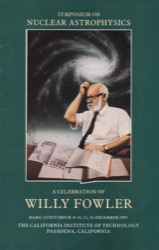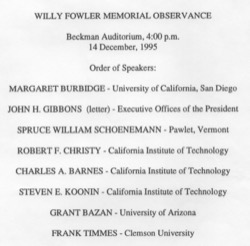
|
Cococubed.com
|
| A Celebration of Willy Fowler |
Home
Astronomy Research
2026 Neutrinos From De-excitation
2024 Radiative Opacity
2024 Neutrino Emission from Stars
2023 White Dwarfs & 12C(α,γ)16O
2023 MESA VI
2022 Earendel, A Highly Magnified Star
2022 Black Hole Mass Spectrum
2021 Skye Equation of State
2021 White Dwarf Pulsations & 22Ne
Software Instruments
2026 AAS Journals
AAS YouTube
Listing of 500+ Author Videos
AAS Peer Review Workshops
Outreach Material
Education Material
Other Stuff:
Bicycle Adventures
Illustrations
Presentations
Equation of State
Stellar Neutrino Emission
The MESA Project
Stellar Neutrinos
Low Energy Nuclear Astrophysics
Celebration of Margaret Burbidge
The MESA Project
Rise of the Elements
White Dwarf Cocktails
Stars and Explosion Models
High Energy Astrophysics
Bonanza of Frontiers
Four Vignettes
Smashing White Dwarfs
Unstable isotopes & Burning
Customizing MESA's pgstar
Hunting SNIa Progenitors
Silicon ejecta from SNIa
NucAstro & Astrobiology
HIPACC SS EOS
NNPSS Lectures
Double degenerate SNIa
Peak Luminosity of SNIa
26Al and 60Fe
A Celebration of Willy Fowler
Contact: F.X.Timmes
my one page vitae,
full vitae,
research statement, and
teaching statement.
gw, pulling fxt aside about an hour before the start, "Can you bottom line it?"
fxt, looking gw right in the eyes, "Yes."
thus, i gave the final talk at the 1995 WAF Celebration.
it has taken awhile for me to get comfortable sharing this one.
 front_cover |
 speakers |
 printed version of talk |
Plain text version:
Within the notion that there are scientific families that parallel personal families, this photograph always puts a smile on my face. For then this picture shows my great-grandfather, my grandfather, my father, and several uncles. Uncle Mike, Uncle Ray, Uncle Dave. I take some of my fashion tips from Grandpa there, and Pop is looking pretty cool in his black Levis.
I wasn't one of William Fowler's graduate students or postdocs, and yet I consider Dr. Fowler to be one the most important influences upon my scientific life. For without the sustained advice, unwavering support, and friendship of his students and collaborators, much, if not all, of the nuclear astrophysics that I am involved in would simply not exist as it does in its present form. I am highly appreciative, and greatly indebted.
Since my principal connection with Willy is through his science, I would like to spend a few moments talking about one aspect of that relationship.
Burbidge, Burbidge, Fowler Hoyle composed a broad and compelling paradigm of how the elements are synthesized in stars. They identified the various processes that operate in stellar interiors, and predicted the chief nucleosynthetic products from the major nuclear burning stages. Some of the details have changed, especially in the light of new physics that was unknown in the late 1950's. For example, scattering by the Z0 intermediate vector boson gives rise to neutral currents, which add a source of neutrino cooling. This cooling affects the core structure of a massive star, which in turn determines to some extent the detailed nucleosynthesis. Burbidge et al. and Cameron posed the following very important question: can the nucleosynthesis that takes place in stars and is forcefully ejected, eventually, after many rounds of star formation, reproduce the measured solar composition? I wish to address this question.
By the mid 1980's various groups had run detailed nuclear reaction networks on specific stages of stellar evolution: core silicon burning, shell oxygen burning, and s-processing during dredge-up to name just a few. These specific studies suggested that a sizable portion of the solar composition could be synthesized. Supernova 1987A arrived and offered several observational tests of stellar evolution and nucleosynthesis, along with providing a few unexpected features. In the early 1990's the index n in Moore's Law (computer speed doubles and price halves every 18 months) had become significant enough to allow the routine use of detailed nuclear reaction networks in very finely gridded stellar evolution models. Coupled with an increase in our knowledge of the physical and evolutionary properties of our Galaxy, the question posed by Burbidge et al. began receiving fresh attention.
The figure shows an example from the results of these recent stellar-chemical evolution studies. In terms of absolute solar abundances, the stable isotopes from hydrogen to zinc range over some 10 orders of magnitude. There are many uncertainties that effect the spread and pattern in the figure, for example; the treatment of convection, residual disagreement on key nuclear reaction rates, functional form of the star formation rate, and even the measured abundances themselves. Certainly this figure does not represent the final answer, nor the first, but it is very encouraging that the isotopic solar composition from hydrogen to zinc is replicated to within a factor of two.
Willy played a central role in this calculation. Directly, by his compilations of the necessary nuclear reaction rates, and indirectly by training and motivating his students, grand-students and great-grand-students. I think a reasonably correct calculation of the isotopic solar composition is a beautiful example of the adventure associated with connecting nuclear physics to astronomy. It is very exciting, and an honor, to assist in propelling the science which Willy had such a profound influence on into the next millenia.
{The "family" photograph on the opposite page was taken by David Arnett in front of The Green Man pub in Granchester, England, at lunchtime, Ca. 1971. From left to right: Syd Falk, Kem Hainbach, Mike Howard, Stan Woosley (identified as Pop in the text), Ray Talbot, F.C. Michel (Caltech BS '55, PhD '62), Cliff Morris, Don Clayton (MS '59, PhD '62, identified as Grandpa in the text), and Willy Fowler}
Figure Caption: Recent models of the chemical evolution of stars have calculated the abundances of stable isotopes from hydrogen to zinc, trying to show that, after many rounds of star formation, this process will eventually reproduce the sun's known composition. The y-axis here gives the calculated abundance divided by the measured solar abundance. The most abundant isotope of a given element is marked by an asterisk and isotopes of the same element are connected by solid lines. If this calculated stellar compsition were the same as the sun's, the isotopes would all lie on the dashed horizontal line. They do, however, replicate solar composition within a factor of two, represented by the horizontal dotted liines.

|

|

|

|

|

|